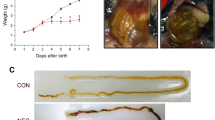Abstract
Background
Necrotizing enterocolitis (NEC) is one of the most severe gastrointestinal diseases in infancy. Hypoxia is known as one of the major risk factors for the development of NEC. Endothelin, known to regulate vasoconstriction, has two receptors (A and B). However, the role of endothelin receptor B (EDNRB) in neonatal intestinal injury remains unclear. We aimed to investigate whether EDNRB is involved in NEC pathophysiology.
Methods
Following ethical approval (#44032), EDNRB hetero knockout mice pups (EDNRB±) and their wild-type (WT) littermates were studied. NEC was induced from postnatal day 5–9 (P5–P9) by hypoxia, gavage feeding of formula and administration of lipopolysaccharide. On P9, the ileum was harvested.
Results
NEC induction in WT mice was associated with mucosal injury. However, EDNRB± NEC mice had reduced mucosal injury. Similarly, EDNRB± mice had significantly lower expression of IL-6 mRNA compared to WT NEC mice. Pimonidazole immunostaining was also significantly lower in EDNRB± compared to WT NEC, suggesting reduced tissue hypoxia.
Conclusions
Partial knockout of EDNRB results in reduced NEC severity and reduced tissue hypoxia. Intestinal perfusion and hypoxia are important elements of NEC pathogenesis. These findings are relevant to the understanding of NEC pathophysiology and to the development of novel preventive strategies for NEC.




Similar content being viewed by others
References
Nino DF, Sodhi CP, Hackam DJ (2016) Necrotizing enterocolitis: new insights into pathogenesis and mechanisms. Nat Rev Gastroenterol Hepatol 13:590–600
Nowicki PT (2005) Ischemia and necrotizing enterocolitis: where, when, and how. Semin Pediatr Surg 14:152–158
Watkins DJ, Besner GE (2013) The role of the intestinal microcirculation in necrotizing enterocolitis. Semin Pediatr Surg 22:83–87
Yanagisawa M, Kurihara H, Kimura S et al (1988) A novel potent vasoconstrictor peptide produced by vascular endothelial cells. Nature 332:411–415
Su BY, Reber KM, Nankervis CA (2004) Developmental expression of endothelin receptors in postnatal swine mesenteric artery. Pediatr Res 56:359–365
Zani A, Cordischi L, Cananzi M et al (2008) Assessment of a neonatal rat model of necrotizing enterocolitis. Eur J Pediatr Surg 18:423–426
Chen Y, Koike Y, Miyake H et al (2016) Formula feeding and systemic hypoxia synergistically induce intestinal hypoxia in experimental necrotizing enterocolitis. Pediatr Surg Int 32:1115–1119
Chan KYY, Leung KT, Tam YH et al (2014) Genome-wide expression profiles of necrotizing enterocolitis versus spontaneous intestinal perforation in human intestinal tissues. Ann Surg 260:1128–1137
Ito Y, Doelle SM, Clark JA et al (2007) Intestinal microcirculatory dysfunction during the development of experimental necrotizing enterocolitis. Pediatr Res 61:180–184
Oktar BK, Gulpinar MA, Bozkurt A et al (2002) Endothelin receptor blockers reduce I/R-induced intestinal mucosal injury: role of blood flow. Am J Physiol Gastrointest Liver Physiol 282:G647–G655
Cuna A, George L, Sampath V (2018) Genetic predisposition to necrotizing enterosolitis in premature infants: Current knowledge, challenges, and future directions. Semin Fetal Neonatal Med 23:387–393
Stobdan T, Zhou D, Ao-leong E et al (2015) Endothelin receptor B, a candidate gene from human studies at high altitude, improves cardiac tolerance to hypoxia in genetically engineered heterozygote mice. Proc Natl Acad Sci U S A 112:10425–10430
Acknowledgements
Dr. Agostino Pierro was supported by the endowment of the Robert M. Filler Chair of Surgery, The Hospital for Sick Children, and by the Canadian Institutes of Health Research (CIHR) Foundation Grant (353857).
Author information
Authors and Affiliations
Corresponding author
Ethics declarations
Conflict of interest
The author declares that there is no competing interest.
Additional information
Publisher's Note
Springer Nature remains neutral with regard to jurisdictional claims in published maps and institutional affiliations.
Rights and permissions
About this article
Cite this article
Miyake, H., Seo, S., Fujiwara, N. et al. Endothelin receptor B affects the perfusion of newborn intestine: possible mechanism of necrotizing enterocolitis development. Pediatr Surg Int 35, 1339–1343 (2019). https://doi.org/10.1007/s00383-019-04559-1
Accepted:
Published:
Issue Date:
DOI: https://doi.org/10.1007/s00383-019-04559-1




